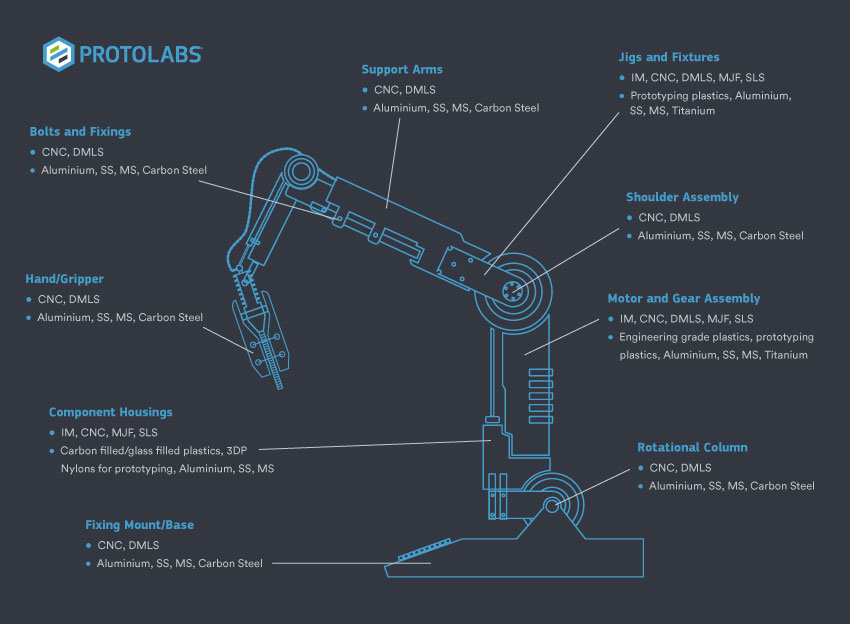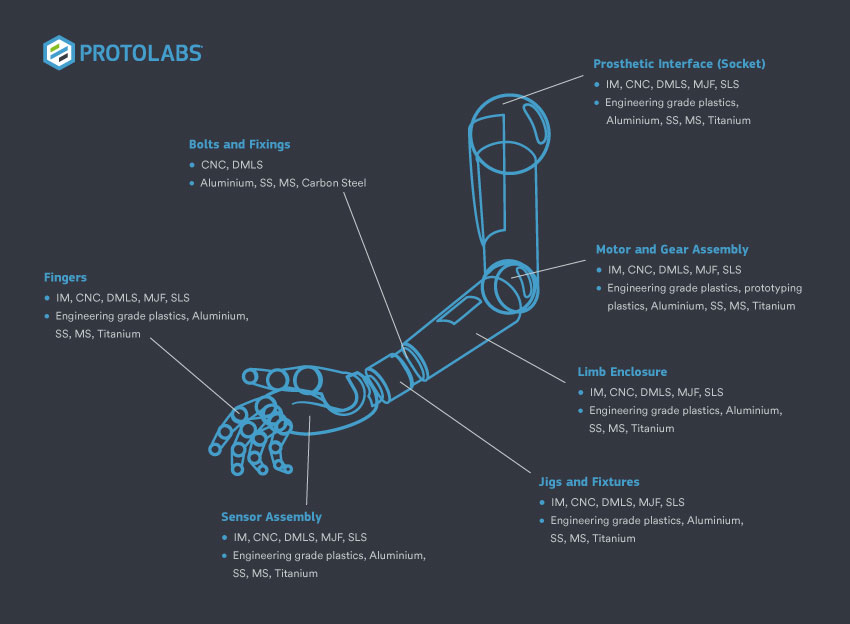Automating the future with artificial intelligence
Creating nimble, innovative, ubiquitous parts to accelerate, automate and streamline industry processes.
ISO 9001:2015
How can digital manufacturing support the Robotics industry?
For components created for the robotics industry, dimensional accuracy is vital. Parts are complex and must be precise to work in sync with other components assembled within a robot. Surviving the stresses of repeatable actions is also essential; for example, robotic arms on a production line would need to repeat the same action thousands of times a day, every day, without fail. Other key considerations include customizability, low-friction surface finishes and complex geometries.
The Robotics industry is broad and diverse and is not limited to the humanoid robots you see in sci-fi movies and robots you see battling on television. Robotics is most prominent in the industrial and manufacturing sectors. Applications here include Robotic Arms, Collaborative Robots (also known as cobots), Robotic process automation, integrated AI, predictive maintenance, and service robots. Robotics is a relatively new industry, dominated by the Americas on the industrial side and its Asian counterparts on the humanoid (android) side. Competition is fierce, with accuracy, repeatability and customizability being key characteristics.
In digital manufacturing, injection moulding, CNC machining, and 3D printing are uniquely valuable in the production and assembly of parts for the robotics industry. Interestingly, these three services utilise robots. Devices such as cartesian manipulators are used for CNC machining, and cloud robotics are used to produce components from CAD files and end effectors supporting tasks such as gripping and grabbing. But look at any industry now, and you are likely to find robotics in some form utilising automation, artificial intelligence and algorithms (such as those used to position them in the jacobian matrix) to complete their job.
Injection Moulding in the Robotics Industry
Injection moulding offers a repeatable option when larger-scale production is required. It can be a more cost-effective option for larger quantities as the same mould is used for each part, and the parts are consistent and precise. Whilst not the key process used for producing robotic components, it is commonly used for production of housings, frames, casings etc. and it's LSR process is becoming increasingly used with the introduction of soft robotics.
Why injection moulding for the Robotics industry?
- Precision Components
- Repeatability
- Light-weight (plastic parts)
- Scalability
- Rapid Prototyping
What are the applications of injection moulded parts in the Robotics industry?
- Housings and Casings
- Frames
- Gears
- Camera Mounting Frame
- LED Indicators
What does Protolabs offer for the Robotics industry using injection moulding?
- Plastic Injection Moulding
- Liquid Silicone Rubber
- Overmoulding and Insert Moulding
- Assembly
- Measurement Inspection
- Part Marking
- Traceability
CNC Machining in the Robotics Industry
CNC machining is the go-to service for the robotics industry due to the precision, materials and in particular dimensional accuracy, which is key when it comes to robotics. CNC also offers tighter tolerances than other services, and its 5-axis process provides high complexity and variation, important for applications that demand precise, repeatable movements. Finally the service allows for controlled surface finishes, which are needed for low-friction components in interactive parts. These aspects make CNC machining perfect for the highly customised parts at low-volumes that robotics often requires.
Why CNC machining for the Robotics industry?
- Precision Parts (important as parts need to fit together perfectly - critical for the proper function of a robot)
- Strong, durable materials
- Can be used to create complex shapes - allows for greater design flexibility
- Fast & Efficient
- Surface Finishes - good for low friction parts required for interacting
- Automated process
What are the applications of CNC machined parts in the Robotics industry?
- Gears
- End Effectors
- Custom Fixtures
- Motor Components
What does Protolabs offer for the Robotics industry using CNC machining?
- Reliably fast manufacturing, typically 3 days from upload to dispatch
- Consistent in-house manufacturing - using standard machines and tools
- CNC Milling
- CNC Turning / CNC Lathé
- Anodising and chromate conversion
- Basic assembly, part marking and inspection reports
3D Printing in the Robotics Industry
3D printing is increasingly used in the robotics industry due to its ability to produce lighter, cheaper, and more efficient parts. It also offers endless possibilities regarding geometries and materials that other services potentially can't provide. 3D Printing also allows for highly customisable, cost-efficient parts and can be a huge time saving as parts can be manufactured in a single piece, rather than several components, which then need to be assembled.
Why 3D printing for the robotics industry?
- Unique features
- Quick Prototyping
- Design Versatility
- Complex Geometries, including lattice structures
- Weight reduction
- Manufacture of parts in a single part, saving time on assembly
- Highly customisable
- Waste Reduction (additive rather than subtractive process)
What are the applications of 3D printed parts in the robotics industry?
- Cameras
- Motors
- Sensors
- Microcontroller
- Feedback devices
- Controllers
- Manipulators
- Robotic Arms
What does Protolabs offer for the robotics industry using 3D printing?
- Stereolithography
- Selective Laser Sintering
- Direct Metal Laser Sintering (Metal 3D printing)
- Multi Jet Fusion
- PolyJet and 3D Printed Silicone (60-65%)
- Post-Process Machining
- Mechanical Testing
- Heat Treatments
- Vapour Smoothing
- Measurement Reports (3D Scan) & First Article Inspections
- Insert fitting/ tapping
- Assembly
- And many more post processing services
What Materials Work Best for the Robotics Industry?

Aluminuim
expand_less expand_moreA popular choice for the robotics industry due to its light-weighting capabilities. Certain alloys also display corrosion resistance, good weldability and high heat resistance, all key characteristics in the robotics industry. For those alloys that don't offer great corrosion resistance, further treatments such as anodisation can be used to improve this characteristic.
Aluminium also offers great surface finishes, which can work well aesthetically for more cosmetic/ on-display robots. It also has the added benefit that is easily machinable, more so than steel, though it is more expensive.
Stainless Steel
expand_less expand_moreA commonly selected material by those in the robotics industry. Stainless steel is the perfect choice for constructing a robot that needs to be sturdy, survive repeatable processes and harsh conditions.
Another benefit is it can be hardened easily, which can be useful when using steel in the framework or body of a robot. It is the perfect material for a part that needs to combine corrosion resistance with high strength and temperature resistance.
POM/Acetal/Delrin
expand_less expand_moreAcetal/Delrin a polyoxymethylene copolymer material, is a common plastic robotics.
The first benefit of plastic is it is light weight. This can be a perfect alternative if a lighter component is required.
Acetal boasts excellent dimensional stability and low friction, both key characteristics for robotic components that may be sliding or performing repeatable actions. This includes applications such as gears, frames, bearings and fasteners.
A final benefit of acetal/ POM materials for the robotics industry is it is relatively inexpensive compared to other common materials used in the industry.
Elastomeric Materials
expand_less expand_moreAn increasingly popular material in the robotics industry due to the introduction of soft robotics. These sort of robotos are particular useful for more delicate tasks that require a less heavy hand. The first fully autonomous soft robot was designed as recently as 2016, with an elastomer-based body, controlled by microfluidic logic and actuated by an embedded pneumatic network (EPN).
Elastomeric materials are also used for internal components in standard robots, such as semiconductors and casings where flex is needed.
Other
expand_less expand_moreRobotics is at the forefront in utilising innovative materials to construct it's components and products.
These materials include polymers, such as collagen, cellulose and chitosan and synthetic polymers, such as polycaprolactone (PCL) and polylactic acid (PLA).
Self-healing materials are often used/ considered in soft robotics in order to prolong life.
Smart materials - often can change their shape in response to several stimuli. Electromechanically active polymers (EAP), also known as artificial muscles. Shape-memory polymers.
Hydrogels, silicones such as polydimethylsioxane (PDMS) and soft composites.
There are also innovative metals and alloys. Such as, Carbon fibre-reinforced composites and nickel-tin alloy Nitinol, which is a shape-memory alloy (SMA).

Manufacturing Robotics Report
An Engineer’s guide to understanding the state of the art in hardware, materials, and the future of robotics manufacturing.
Read moreWhy Protolabs for Components and Equipment in the Robotics Industry?
Automated, Precision, CNC Machined Parts
Leverage high-speed 3-axis and 5-axis milling processes as well as turning with live tooling for increasingly complex, precision metal and plastic components.
Customisation & On-Demand Production
Whether it be highly tailored, unique parts at low-volumes, or repeatable parts at production volumes, Protolabs has services that can meet your needs.
![]()
Rapid Prototyping
R&D is a big thing for the robotics industry. Our design for manufacturability service allows you to upload CAD models and receive analysis on whether the part is manufacturable, free of charge and as many times as you like. We also offer a consultative design service if you need support in making your product manufacturable. Our digital manufacturing services then support the iteration and functional testing processes.
Quality Certifications and Traceability
Take advantage of our ISO9001-certified manufacturing processes for high-requirement parts.
Materials
Choose from machined metals like aluminium, titanium, and stainless steel 17-4 PH along with plastics such as POM and elastomeric resins.
How Design for Manufacturability can support your Product Life Cycle
Parts designed for robotics are often required to be nimble and withstand the stresses of repeat processes. When developing these parts, testing is vital as it can give you the advantage needed to stay ahead of the competition. Protolabs' design for manufacturability (DFM) service can provide you with a quote within hours. This means design and iteration has never been quicker or easier. To support you even further, if your part comes back as not manufacturable, our expert team of Application Engineers are on-hand to discuss and help you in finalising a part that Protolabs can produce. Once you design has been quoted, it's simply a case of ordering your functional prototypes using our rapid prototyping services, which can ship parts in as little as 1 day.
"The Protolabs quoting platform is always really quick and we also get manufacturing feedback from them. The system automatically details any issues which means that we can address those issues before anything goes out for manufacture. That's really handy and it's so easy to upload a file."
“It was an extraordinary engineering challenge that was met by an extraordinary service from Protolabs. We appreciated their efficiency, expertise, attention to detail and the speed was something that not many other manufacturers could have achieved. Once we had the material locked in, Protolabs were able to mould the parts and get them shipped out to us extremely swiftly."
“The auto-quoting system is amazing. Within a day, you get an answer as to whether you can make the part, whether you need to make changes, etc. And you can do that quickly, upload a new version, and get a part in a couple of days as opposed to a week just for a quote from other manufacturers.”



















